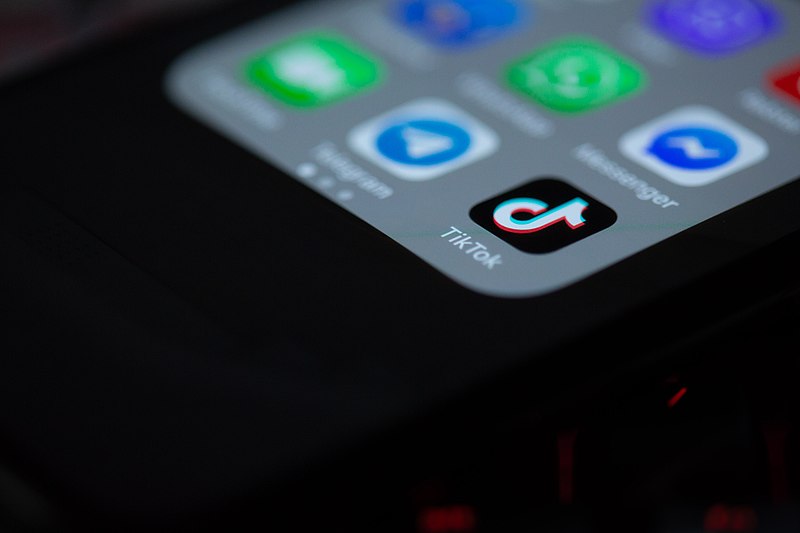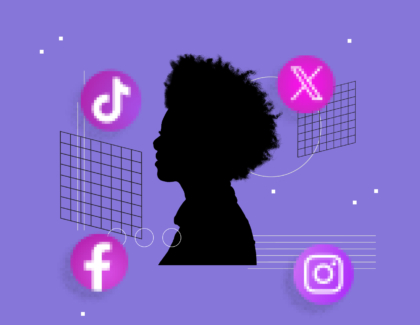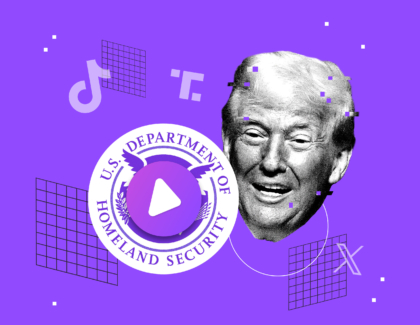Sign up for the daily CJR newsletter.
This article was featured in the Tow Center for Digital Journalism’s weekly newsletter. Subscribe here to stay up to date on our latest events and publications.
TikTok, the rapidly growing video platform owned by ByteDance, clocked one billion monthly active users in 2021, years earlier in its life span than Facebook and Instagram hitting that figure.
TikTok is a rising global source for news. The platform is now used for news by 7 percent of UK adults, according to the country’s communications regulator Ofcom, driven by users aged sixteen to twenty-four.
Meanwhile, TikTok’s global ad revenues are expected to triple this year, to over $11 billion, according to estimates by Insider Intelligence, eclipsing the sales of Twitter and Snapchat combined.
This has transformed TikTok into a political battleground, despite the platform’s total ban on political and cause-based advertising. Across the political spectrum, companies and nonprofits are paying influencers to promote causes or candidates—in videos that are often hard to determine are paid and run without disclosure—activity that is expected to ramp up before the midterms in November.
We spoke to Becca Ricks, a senior researcher at the Mozilla Foundation, whose investigative work highlighted how partisan influencers are evading TikTok’s weak political-ad policies. (The conversation has been edited for clarity and length.)
JB: TikTok has one of the strictest policies on political advertising. Can you sketch what its ad policies are and how they differ from other social media companies’?
BR: So TikTok prohibits political advertising. They’re not necessarily unique in that. But one reason we started looking at TikTok was to better understand how that policy was enforced. This is always an area that’s really slippery, even for platforms like Facebook that do permit political advertising: How do you define political advertising? “Issue-based ads” are always a little bit of a slippery category. And so this was one of the reasons we wanted to scrutinize the platform. We looked at influencers who were posting on the platform since the 2020 US election.
@joieculin So grateful for this opportunity 🤍🤍 #tpusa #turningpointusa #influencer #ambassador #florida ♬ Celebrate the Good Times – Mason
JB: And your findings showed the policy doesn’t work in practice, and enforcement in some cases appears to be nonexistent. Can you say more about that?
BR: Yeah, so it’s worth saying there were a couple of investigations before we started—for example, the BBC were looking at how political TikTokers were not declaring paid content after being paid by left-wing organizations in the US. Right now the responsibility for disclosing paid content generally is primarily taken on by the company that’s paying the influencer and the influencer themselves. One of the things we made the argument for was that responsibility should be on the platform as well.
JB: One gray area you identified was “paid partnerships,” which don’t seem to be marked as ads on the platform and rely on self-reporting. Can you outline why that self-disclosure element is concerning?
BR: So we identified this problem even outside of that category of political ads. But in general, the FTC [Federal Trade Commission] has guidelines for how influencers and content creators in the US should be disclosing when something’s an ad. And right now, that largely amounts to adding #ad or #sponsored to a post. But if you’re just scrolling through TikTok, you can encounter lots of examples of gray areas where it’s unclear whether it’s being sponsored, where self-disclosure isn’t happening, because the burden falls on the content creator. TikTok is, I believe, in the process of changing that policy. For example, Instagram has self-disclosure tools, where you tick a box saying a post is sponsored, and it automatically adds that tag.
JB: To give some concrete examples, in what ways—and what causes—have people skirted these rules?
BR: In our research, we started broadly, looking at clusters of political influencers on TikTok, looking at the Republican hype house, the Democratic hype house, groups of content creators making political content. We wanted to know whether these political influencers seem to be getting financial or material compensation from political groups.
Then we zeroed in on conservative organizations like Turning Point USA. They’re a nonprofit, and they have a dedicated influencer program that’s specifically targeted at funding young conservative content creators on social media. We found a number of influencers who had been flown out to their events or had talked about their relationship with TPUSA. We dug a little bit more into TPUSA’s 2009 tax filings, looking at how much money they were spending on influencer programs.
@taylormjewett 5 days in 15 seconds. i love you all so much!!!! ❤️ #todayisamerica #sas2020 #trump2020 #conservative #tpusa ♬ original sound – lindsay
The challenge is that, in all these cases, the relationship with content creators isn’t necessarily straightforward. If you have a large network of micro-influencers who are being paid to make or share content, we don’t have the details about how that works. And policymaking isn’t equipped to deal with or it hasn’t caught up with what’s happening on these platforms.
JB: You mentioned Turning Point USA’s network of micro-influencers, and other organizations are doing similar things. In your research you say some of this could be funded by what’s considered “dark money.” Could you say more about that?
BR: What we found doing our investigation is it prompted more questions than answers. Because what we learned is the nature of paid political influence is evolving in order to meet the demands of this new influencer economy. Sometimes we ourselves were asking the question: Would this violate TikTok’s policies? It raised questions of how do you define violations, how you define political advertising—where do you draw that line?
It stems from how micro-influencing is an evolution of traditional models for thinking about advertising. Policy is equipped to deal with placing a political ad, through a platform, how you place and disclose it. But a lot of that doesn’t exist for influencer advertising. It’s a Wild West in terms of policy.
JB: You mentioned micro-influencers on TikTok are an extension of traditional forms of advertising. Can you elaborate on that?
BR: I mean, we’ve seen examples of micro-influencing happening in terms of very localized messages, to a particular state or community. But moving micro-influencing into a political context becomes very troublesome. There’s a whole new set of vulnerabilities and risks. The amount of money spent is so small, the bubble of influence is so much smaller, that it’s much more difficult to get visibility on what’s happening across the platform. That’s a concern ahead of the election season.
JB: I’m interested in your thoughts on what people hope to get out of this. The famous quote attributed to Breitbart is that “politics is downstream from culture.” What are these political actors hoping to gain from TikTok—are they trying to sway culture by reaching a younger audience?
BR: It’s interesting. When we were reading through, for example, Turning Point essays about their influencer program, a lot of this is about ensuring there’s a new generation of conservative leaders and thought leaders in the influencer space. They’re thinking about the next generation of politics and ensuring that they’re nurturing new leaders in that space. And we’re seeing this across the political spectrum. A few weeks ago, Vice did some interesting reporting around left-wing influencers on TikTok being paid to hype Democrats’ accomplishments ahead of the midterms.
@ringringdinophone♬ original sound – ringringdinophone
JB: Really interesting. To ask about craft, how did you investigate this?
BR: One of the challenges we faced is TikTok doesn’t have an official public API [application programming interface] for researchers to use and see how the app structures information. They have an API available for developers integrating TikTok into their apps, but no tool to poke at what’s happening on their platform. So what we did was a little bit exploratory. We started with an unofficial TikTok wrapper—essentially, it’s built around the browser experience of TikTok, and it allows us to query the API to learn how things are labeled internally.
We were able to query the API to create lists of related users and hashtags. We started with a number of what we call seed accounts—like the Republican hype house, Democratic hype house. From that, we were able to generate a cluster of associated political influencers and hashtags. That was the starting point to go through influencers’ pages. Then we went manually through a bunch of posts, looking for language indicating a material relationship with political organizations. So we used an API to aid our research, but essentially went through manually and looked at a lot of videos.
JB: Coming onto the midterms, what are you expecting—is this the first proper TikTok election?
BR: Yeah, it’s going to be very, very different from two years ago. TikTok has grown so much since then. Some estimates say TikTok will surpass Facebook for advertising money spent on influencer marketing in the US by the end of 2022, and surpass YouTube by 2024.
This is a platform that’s not only growing rapidly, but also a lot of agencies really have their eyes on TikTok, specifically on influencing. This is an area with a lot of money being thrown at it right now. There are a lot more PR agencies and political groups with eyes on TikTok now that didn’t two years ago—especially in micro-influencing.
Another thing to keep an eye on outside the influencer economy is politicians getting on the platform, getting familiar with it, figuring out how to post. A report we did on the [September 2021] German election—a number of politicians created their first TikTok accounts. But also some accounts which appeared to be authentic were actually inauthentic, with thousands of followers. TikTok needs a proactive strategy for ensuring the authenticity of accounts like this.
JB: What are your wider recommendations for TikTok and lawmakers for getting a grip on nefarious political advertising?
BR: The recommendations we made to TikTok were first around honing self-disclosure tools for influencers, making sure it’s easy to disclose an ad. Because right now it’s voluntary, and there doesn’t seem to be much enforcement on influencers putting #ad or #sponsored. We’re also pushing for ad transparency: releasing an ad archive, ad library, or ad API like Facebook. Whatever tools they can develop to make advertising more transparent, to enable independent research, will strengthen this whole space. And then policy enforcement. TikTok has a number of detailed policies. Enforcement is another question. So making sure those policies have money behind them, the investment behind them to be enforced, to ensure there aren’t loopholes.
In terms of our recommendations to lawmakers, right now especially in the European Union there’s a lot of disclosure obligations ramping up around online advertising, like the DSA [Digital Services Act]. We want to see better requirements around ad disclosures. We also think any regulation should start thinking more about new forms of political influence and advertising—a lot of policy approaches advertising in a very traditional way. Policymakers should start thinking about novel forms of influence, like micro-influencing, the influencer economy. Finally, focusing on transparency: making sure there are laws and guidelines requiring platforms to enhance user-facing transparency.
JB: In your conversations with people at TikTok, do you get a sense they understand the importance of this stuff?
BR: Yeah, the folks working on policy do understand. Their policies are written quite detailed and strong. The challenge is always going to be around enforcement and prioritization. It’s great to have certain policies in place, but if those policies aren’t backed up by engineering resources, investing in enforcement, they aren’t going to be meaningful and effective.
JB: Anything you wanted to add?
BR: TikTok is a really interesting case. The platform has a lot of unique aspects, so the risks and vulnerabilities are going to be different. Policy needs to match those risks. One of my takeaways from this work is that TikTok is a relatively young platform, but it’s experiencing a massive infusion of cash. They should have learned lessons from some of the failures of its predecessors—like Facebook and Twitter—and this is an opportunity for them to really get strong on policy and enforcement.
Has America ever needed a media defender more than now? Help us by joining CJR today.









